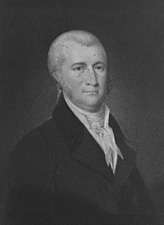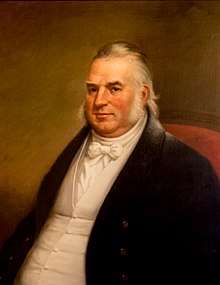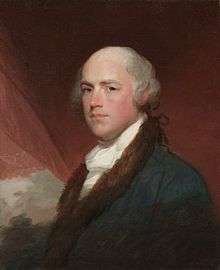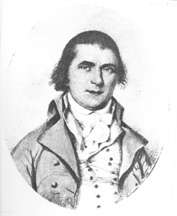1804 and 1805 United States Senate elections
The United States Senate elections of 1804 and 1805 were elections that expanded the Democratic-Republican Party's overwhelming control over the United States Senate. The Federalists went into the elections with such a small share of Senate seats (9 out of 34, or 27%) that even if they had won every election, they would have still remained a minority caucus.
| |||||||||||||||||||||||||
11 of the 34 seats in the United States Senate (plus special elections) 18 seats needed for a majority | |||||||||||||||||||||||||
|---|---|---|---|---|---|---|---|---|---|---|---|---|---|---|---|---|---|---|---|---|---|---|---|---|---|
| |||||||||||||||||||||||||
| |||||||||||||||||||||||||
As these elections were prior to the ratification of the Seventeenth Amendment, senators were chosen by state legislatures.
Results summary
Senate Party Division, 9th Congress (1805–1807)
- Majority Party: Democratic-Republican (27)
- Minority Party: Federalist (7)
- Other Parties: 0
- Total Seats: 34
Change in composition
Only reflects results of regular elections.
Before the regular elections
| DR7 | DR6 | DR5 | DR4 | DR3 | DR2 | DR1 | |||
| DR8 | DR9 | DR10 | DR11 | DR12 | DR13 | DR14 | DR15 | DR16 | DR17 |
| Majority → | DR18 | ||||||||
| F8 N.J. Ran |
F9 N.H. Unknown |
DR25 Tenn. Retired |
DR24 Va. Ran |
DR23 S.C. Ran |
DR22 R.I. Ran |
DR21 N.C. Ran |
DR20 Ky. Ran |
DR19 Ga. Ran | |
| F7 Mass. Ran |
F6 Del. Ran |
F5 | F4 | F3 | F2 | F1 | |||
Result of the regular elections
| DR7 | DR6 | DR5 | DR4 | DR3 | DR2 | DR1 | |||
| DR8 | DR9 | DR10 | DR11 | DR12 | DR13 | DR14 | DR15 | DR16 | DR17 |
| Majority → | DR18 | ||||||||
| DR27 N.J. Gain |
DR26 N.H. Gain |
DR25 Tenn. Hold |
DR24 R.I. Hold |
DR23 N.C. Hold |
DR22 Ky. Hold |
DR21 Va. Re-elected |
DR20 S.C. Re-elected |
DR19 Ga. Re-elected | |
| F7 Mass. Re-elected |
F6 Del. Re-elected |
F5 | F4 | F3 | F2 | F1 | |||
| Key: |
|
|---|
Race summaries
Except if/when noted, the number following candidates is the whole number vote(s), not a percentage.
Special elections during the 8th Congress
In these special elections, the winner was seated during 1804 or before March 4, 1805; ordered by election date.
| State | Incumbent | Results | Candidates | ||
|---|---|---|---|---|---|
| Senator | Party | Electoral history | |||
| New York (Class 3) |
John Armstrong Jr. | Democratic-Republican | 1800 (Special) 1801 1802 (Resigned) 1803 (Appointed) |
Interim appointee resigned December 3, 1804 to become U.S. Senator from Class 1 seat. New senator elected February 3, 1804. Democratic-Republican hold. |
|
| New York (Class 1) |
Theodorus Bailey | Democratic-Republican | 1803 | Resigned January 16, 1804 to become Postmaster of New York City. New senator elected February 3, 1804. Democratic-Republican hold. |
|
| Rhode Island (Class 1) |
Samuel J. Potter | Democratic-Republican | 1802 | Died October 14, 1804. New senator elected October 29, 1804. Democratic-Republican hold. |
|
| New York (Class 1) |
John Armstrong Jr. | Democratic-Republican | 1804 (Special) | Resigned to become U.S. Minister to France. New senator elected November 9, 1804. Democratic-Republican hold. |
|
| Delaware (Class 2) |
William H. Wells | Federalist | 1799 (Special) 1799 |
Resigned November 6, 1804. New senator elected November 13, 1804. Winner also elected to the next term, see below. Federalist hold. |
|
| Virginia (Class 1) |
Andrew Moore | Democratic-Republican | 1804 (Appointed) | Interim appointee resigned December 3, 1804 to become U.S. Senator from Class 1 seat. New senator elected December 4, 1804. Democratic-Republican hold. |
|
| Virginia (Class 2) |
William B. Giles | Democratic-Republican | 1804 (Appointed) | Interim appointee resigned December 3, 1804 to become U.S. Senator from Class 2 seat. New senator elected December 4, 1804. Winner also elected to the next term, see below. Democratic-Republican hold. |
|
| South Carolina (Class 3) |
Pierce Butler | Democratic-Republican | 1802 (Special) | Resigned November 21, 1804. New senator elected December 6, 1804. Democratic-Republican hold. |
|
Races leading to the 9th Congress
In these regular elections, the winner was seated on March 4, 1805; ordered by state.
All of the elections involved the Class 2 seats.
| State | Incumbent | Results | Candidates | ||
|---|---|---|---|---|---|
| Senator | Party | Electoral history | |||
| Delaware | James A. Bayard | Federalist | 1804 (Special) | Incumbent re-elected January 24, 1805. |
|
| Georgia | Abraham Baldwin | Democratic- Republican |
1799 | Incumbent re-elected November 14, 1804. |
|
| Kentucky | John Brown | Democratic- Republican |
1792 (New seat) 1792 1798 |
Incumbent lost re-election. New senator elected in 1804 on the seventh ballot. Democratic-Republican hold. |
|
| Massachusetts | Timothy Pickering | Federalist | 1803 (Special) | Incumbent re-elected February 6, 1805 on the third ballot. |
|
| New Hampshire | Simeon Olcott | Federalist | 1801 (Special) | Unknown if incumbent retired or lost re-election. New senator elected November 28, 1804. Democratic-Republican gain. |
|
| New Jersey | Jonathan Dayton | Federalist | 1798 | Incumbent lost re-election. New senator elected in 1804. Democratic-Republican gain. |
|
| North Carolina | Jesse Franklin | Democratic- Republican |
1798 | Incumbent lost re-election. New senator elected in 1804 on the fifth ballot. Democratic-Republican hold. Winner would later reject his election and never take the seat. A new election was held the next year, see below. |
|
| Rhode Island | Christopher Ellery | Democratic- Republican |
1801 (Special) | Incumbent lost re-election. New senator elected in 1804. Democratic-Republican hold. |
|
| South Carolina | Thomas Sumter | Democratic- Republican |
1801 | Incumbent elected December 6, 1804. |
|
| Tennessee | William Cocke | Democratic- Republican |
1799 (Special) | Incumbent retired. New senator elected early September 23, 1803. Democratic-Republican hold. |
|
| Virginia | William B. Giles | Democratic- Republican |
1804 (Appointed) 1804 (Resigned) 1804 (Special) |
Incumbent re-elected December 7, 1804. |
|
Special elections during the 9th Congress
In this special election, the winner was seated in 1805 after March 4.
| State | Incumbent | Results | Candidates | ||
|---|---|---|---|---|---|
| Senator | Party | Electoral history | |||
| Kentucky (Class 3) |
John Breckinridge | Democratic-Republican | 1800 | Resigned August 7, 1805 to become U.S. Attorney General. New senator elected November 8, 1805. Democratic-Republican hold. |
|
| North Carolina (Class 2) |
Vacant | Montfort Stokes (DR) had been elected in 1804, see above, but rejected the position. New senator elected November 22, 1805. Democratic-Republican gain. |
| ||
Delaware

There were two elections this cycle to the same seat, because Federalist William H. Wells, who had first been elected in 1799, resigned November 6, 1804.
Delaware (Regular)
Federalist James A. Bayard was elected November 13, 1804, to finish the term ending the following March.
Delaware (Special)
Federalist James A. Bayard also elected in 1805, to the next term.
Georgia
Kentucky
Massachusetts
New Hampshire
New Jersey
New York (Special)
In February 1804 two senators were elected to finish vacant terms. The winner of the class 1 seat later resigned, leading to a November special election.
Theodorus Bailey had been elected to the Class 1 seat (term 1803-1809) but resigned on January 16, 1804, after his appointment as Postmaster of New York City.
John Armstrong had been re-elected to the class 3 seat to the term that would end March 3, 1807. He resigned February 5, 1802 and DeWitt Clinton was elected February 9, 1802 to finish the term.
Clinton then resigned on November 4, 1803, after his appointment as Mayor of New York City, and Governor George Clinton appointed Armstrong to his old seat to continue the term temporarily until another special election.
Armstrong was then elected to the Class 1 seat and so resigned from the Class 3 seat.
New York (February: Special Classes 1 and 3)
The first special election was held February 3, 1804, by the New York State Legislature to elect both senators. The class 1 term ended March 3, 1809 and the class 3 term ended March 3, 1813.
U.S. Senator (Class 1) Incumbent: Theodorus Bailey
| House | Democratic-Republican | Federalist | Federalist | |||
|---|---|---|---|---|---|---|
| State Senate (32 members) |
||||||
| State Assembly (99 members) |
83 | Jacob Radcliff | 4 | Egbert Benson | 3 | |
U.S. Senator (Class 3) Incumbent: John Armstrong
| House | Democratic-Republican | Federalist | Federalist | |||
|---|---|---|---|---|---|---|
| State Senate (32 members) |
||||||
| State Assembly (99 members) |
Smith was nominated unanimously by the Assembly, but the exact number of votes given is unclear. | |||||
John Smith was seated February 23, 1804. John Armstrong was seated February 25, 1804.
New York (November: Special class 1)
Once again, John Armstrong resigned from the Senate on June 30, 1804 (a third time in three years) when appointed U.S. Minister to France. To fill the vacancy, the legislature held a special election November 9, 1804, and elected Samuel L. Mitchill.
| House | Democratic-Republican | Federalist | Democratic-Republican | |||
|---|---|---|---|---|---|---|
| State Senate (30 members) |
||||||
| State Assembly (100 members) |
75 | Rufus King | 14 | David Thomas | 1 | |
Mitchill was seated November 23, 1804.
North Carolina
Rhode Island
Rhode Island (Regular)

Democratic-Republican James Fenner beat incumbent Democratic-Republican Christopher Ellery in 1804.
Rhode Island (Special)
Democratic-Republican Samuel J. Potter died October 14, 1804 Democratic-Republican Benjamin Howland was elected October 29, 1804 to finish the term.
South Carolina
South Carolina (Regular)

Democratic-Republican Thomas Sumter was re-elected December 6, 1804.
South Carolina (Special)

Democratic-Republican Pierce Butler resigned November 21, 1804 and Democratic-Republican John Gaillard was elected December 6, 1804.
Tennessee
Virginia
The incumbent senators effectively switched seats due to appointments and special elections.
Class 2

until May 22, 1804

August 11, 1804 – December 3, 1804

from December 4, 1804
Virginia (Special, Class 2)
Democratic-Republican Wilson C. Nicholas resigned May 22, 1804 and Democratic-Republican Andrew Moore was appointed August 11, 1804 to continue the term. Moore was elected to the other seat, so he resigned and Democratic-Republican William B. Giles, who had already been elected to this seat's next term, was elected December 4, 1804 to finish the term.
Virginia (Regular, Class 2)
Democratic-Republican William B. Giles was elected December 4, 1804 to the next term.
Virginia (Special, Class 1)

until June 7, 1804

August 11, 1804 – December 3, 1804

from December 4, 1804
Democratic-Republican Abraham B. Venable resigned June 7, 1804 and Democratic-Republican William B. Giles was appointed August 11, 1804 to continue the term. Giles was elected to the other seat, so he resigned and Democratic-Republican Andrew Moore was elected December 4, 1804 to finish the term.
See also
- United States elections, 1804
- 1804 United States presidential election
- United States House of Representatives elections, 1804
- 8th United States Congress
- 9th United States Congress
Notes
- "New York 1804 U.S. Senate, Special". Tufts Digital Collations and Archives. A New Nation Votes: American Election Returns 1787–1825. Tufts University. Retrieved February 8, 2018., citing Journal of the New York Assembly, 1804. 35. Journal of the New York State Senate, 1804. 10.
- "NY US Senate". Our Campaigns. Retrieved February 23, 2015.
- "New York 1804 U.S. Senate, Special". Tufts Digital Collations and Archives. A New Nation Votes: American Election Returns 1787–1825. Tufts University. Retrieved February 8, 2018., citing The Albany Register (Albany, NY). February 7, 1804.
- "NY US Senate". Our Campaigns. Retrieved February 23, 2015.
- "Rhode Island 1804 U.S. Senate, Special". Tufts Digital Collations and Archives. A New Nation Votes: American Election Returns 1787–1825. Tufts University. Retrieved February 10, 2018., citing The True American and Commercial Advertiser (Philadelphia, PA). November 19, 1804.
- "NY US Senate". Our Campaigns. Retrieved February 23, 2015.
- "Delaware 1804 U.S. Senate, Special". Tufts Digital Collations and Archives. A New Nation Votes: American Election Returns 1787–1825. Tufts University. Retrieved February 8, 2018., citing Journal of the Delaware House of Representatives, 1804. 9.
- "Delaware 1805 U.S. Senate". Tufts Digital Collations and Archives. A New Nation Votes: American Election Returns 1787–1825. Tufts University. Retrieved February 8, 2018., citing Journal of the Delaware State Senate, 1805. 41.
- "Georgia 1804 U.S. Senate". Tufts Digital Collations and Archives. A New Nation Votes: American Election Returns 1787–1825. Tufts University. Retrieved February 8, 2018., citing The Enquirer (Richmond, VA). December 6, 1804.
- "Kentucky 1804 U.S. Senate, Ballot 7". Tufts Digital Collations and Archives. A New Nation Votes: American Election Returns 1787–1825. Tufts University. Retrieved February 8, 2018., citing Kentucky Gazette and General Advertiser (Lexington, KY). November 27, 1804.
- "Massachusetts 1805 U.S. Senate, Ballot 3". Tufts Digital Collations and Archives. A New Nation Votes: American Election Returns 1787–1825. Tufts University. Retrieved January 29, 2018., citing The Providence Phoenix (Providence, RI). February 9, 1805.
- "New Hampshire 1804 U.S. Senate". Tufts Digital Collations and Archives. A New Nation Votes: American Election Returns 1787–1825. Tufts University. Retrieved February 8, 2018., citing Oracle Post (Portsmouth, NH). December 11, 1804.
- "New Jersey 1804 U.S. Senate". Tufts Digital Collations and Archives. A New Nation Votes: American Election Returns 1787–1825. Tufts University. Retrieved February 8, 2018., citing The Centinel of Freedom (Newark, NJ). November 13, 1804.
- "North Carolina 1804 U.S. Senate, Ballot 5". Tufts Digital Collations and Archives. A New Nation Votes: American Election Returns 1787–1825. Tufts University. Retrieved February 9, 2018., citing Raleigh Register, and North-Carolina State Gazette (Raleigh, NC). December 3, 1804.
- "Rhode Island 1804 U.S. Senate". Tufts Digital Collations and Archives. A New Nation Votes: American Election Returns 1787–1825. Tufts University. Retrieved February 10, 2018., citing The True American and Commercial Advertiser (Philadelphia, PA). November 19, 1804.
- "South Carolina 1804 U.S. Senate". Tufts Digital Collations and Archives. A New Nation Votes: American Election Returns 1787–1825. Tufts University. Retrieved February 10, 2018., citing Original Election Returns. South Carolina Department of Archives and History, Columbia.
- "Tennessee 1803 U.S. Senate, Special". Tufts Digital Collations and Archives. A New Nation Votes: American Election Returns 1787–1825. Tufts University. Retrieved January 30, 2018., citing Journal of the Tennessee House of Representatives, 1803. 27. Gazette of the United States (Philadelphia, PA). October 18, 1803. White, Robert Hiram. Messages of the Governors of Tennessee, 1796-1821. Vol. 1. Nashville: The Tennessee Historical Commission, 1952.
- "Virginia 1804 U.S. Senate". Tufts Digital Collations and Archives. A New Nation Votes: American Election Returns 1787–1825. Tufts University. Retrieved February 10, 2018., citing The Enquirer (Richmond, VA). December 15, 1804.
- "Kentucky 1805 U.S. Senate, Special". Tufts Digital Collations and Archives. A New Nation Votes: American Election Returns 1787–1825. Tufts University. Retrieved February 8, 2018., citing The Enquirer (Richmond, VA). December 6, 1805.
- "North Carolina 1805 U.S. Senate". Tufts Digital Collations and Archives. A New Nation Votes: American Election Returns 1787–1825. Tufts University. Retrieved February 9, 2018., citing Legislative Papers. State Archives of North Carolina, Raleigh.
References
- Party Division in the Senate, 1789-Present, via Senate.gov